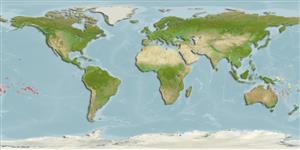Actinopterygii (ray-finned fishes) >
Perciformes (Perch-likes) >
Labridae (Wrasses) > Corinae
Etymology: Pseudojuloides: Greek, pseudes = false + Greek, iouis = a fish without identification, perhaps some of genus Coris cited by Plinius + Greek, oides = similar to (Ref. 45335). More on author: Randall.
Environment / Climate / Range
Ecology
Marine; reef-associated; depth range 12 - 31 m (Ref. 1602). Tropical, preferred ?; 14°N - 28°S
Pacific Ocean: Guam to the Society, Tuamoto, Austral and Ducie islands.
Size / Weight / Age
Maturity: Lm ? range ? - ? cm
Max length : 13.0 cm TL male/unsexed; (Ref. 9710)
Dorsal
spines
(total): 9;
Dorsal
soft rays
(total): 11;
Anal
spines: 3;
Anal
soft rays: 12. The primary phase of P. atavai closely resembles juvenile Thalassoma amblycephalum; the terminal phase is orange-yellow anteriorly with dull violet squiggly lines on the head and reddish horizontal and vertical lines on the body, becoming abruptly bluish-black posteriorly (Ref. 1602). Caudal fin not very short (length 1.3 to 1.5 times in head length). First dorsal-fin ray longest. Snout 2.7 to 2.9 times in head length (Ref 9823).
Found well above the bottom of exposed seaward reefs and clear lagoons (Ref. 9710). Feeds on small invertebrates (Ref. 89972).
Life cycle and mating behavior
Maturity | Reproduction | Spawning | Eggs | Fecundity | Larvae
Oviparous, distinct pairing during breeding (Ref. 205).
Randall, J.E. and H.A. Randall, 1981. A revision of the labrid fish genus Pseudojuloides, with descriptions of five new species. Pac. Sci. 35(1):51-74. (Ref. 2140)
IUCN Red List Status (Ref. 115185)
CITES (Ref. 94142)
Not Evaluated
Threat to humans
Harmless
Human uses
More information
ReferencesAquacultureAquaculture profileStrainsGeneticsAllele frequenciesHeritabilityDiseasesProcessingMass conversion
Tools
Special reports
Download XML
Internet sources
